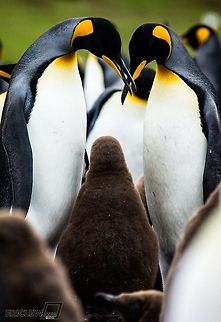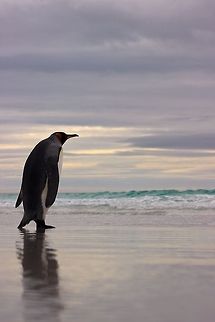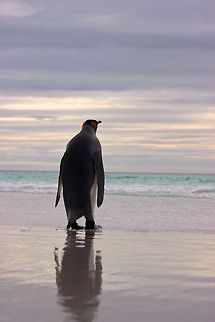
Distribution
King Penguins breed on subantarctic islands between 45 and 55°S, at the northern reaches of Antarctica, as well as Tierra del Fuego, the Falkland Islands, and other temperate islands of the region. The total population is estimated to be 2.23 million pairs and is increasing. The largest breeding populations are on Crozet Island, with around 455,000 pairs, 228,000 pairs on the Prince Edward Islands, 240,000–280,000 on the Kerguelen Islands and over 100,000 on the South Georgia Islands. Macquarie Island has around 70,000 pairs. The non-breeding range is poorly known though presumably the subantarctic waters of the southern Indian, South Atlantic and Asian part of the Southern Ocean. Vagrant birds have been recorded from the Antarctic peninsula as well as South Africa, Australia and New Zealand.The Nature Protection Society released King Penguins in Gjesvær in Finnmark, and Røst in Lofoten in northern Norway in August 1936. Birds were reported in the area several times in the 1940s though none have been seen since 1949.

Behavior
American zoologist Gerry Kooyman revolutionized the study of penguin foraging behaviour in 1971 when he published his results from attaching automatic dive-recording devices to Emperor Penguins, and recording a dive of 235 metres by a King Penguin in 1982. The current maximum dive recorded is 343 metres in the Falkland Islands region, and a maximum time submerged of 552 seconds recorded at the Crozet Islands. The King Penguin dives to depths of 100–300 meters , spending around 5 minutes submerged, during daylight hours, and less than 30 metres at night.The majority of dives undertaken by King Penguins are flat-bottomed; that is, the penguin dives to a certain depth and remains there for a period of time hunting before returning to the surface. They have been described as U-shaped or W-shaped, relating to the course of the dive. The bird dives in a V-shaped or 'spike' pattern in the remaining 12% of dives; that is the bird dives at an angle through the water column, reaches a certain depth and then returns to the surface. Other penguins dive in this latter foraging pattern in contrast. Observations at Crozet Islands revealed most King Penguins were seen within 30 km of the colony. Using the average swimming speed, Kooyman estimated the distance travelled to foraging areas at 28 km .
Its average swimming speed is 6.5–10 km/h . On shallower dives under 60 m , it averages 2 km/h descending and ascending, while on deeper dives over 150 m deep, it averages 5 km/h in both directions. King Penguins also porpoise, a swimming technique used to breathe while maintaining speed. On land, the King Penguin alternates between walking with a wobbling gait and tobogganing—sliding over the ice on its belly, propelled by its feet and wing-like flippers. Like all penguins, it is flightless.

Habitat
King Penguins breed on subantarctic islands between 45 and 55°S, at the northern reaches of Antarctica, as well as Tierra del Fuego, the Falkland Islands, and other temperate islands of the region. The total population is estimated to be 2.23 million pairs and is increasing. The largest breeding populations are on Crozet Island, with around 455,000 pairs, 228,000 pairs on the Prince Edward Islands, 240,000–280,000 on the Kerguelen Islands and over 100,000 on the South Georgia Islands. Macquarie Island has around 70,000 pairs. The non-breeding range is poorly known though presumably the subantarctic waters of the southern Indian, South Atlantic and Asian part of the Southern Ocean. Vagrant birds have been recorded from the Antarctic peninsula as well as South Africa, Australia and New Zealand.The Nature Protection Society released King Penguins in Gjesvær in Finnmark, and Røst in Lofoten in northern Norway in August 1936. Birds were reported in the area several times in the 1940s though none have been seen since 1949.

Reproduction
The King Penguin is able to breed at three years of age, although only a very small minority actually do then; the average age of first breeding is around 6 years. King Penguins are serially monogamous. They have only one mate each year, and stay faithful to that mate. However, fidelity between years is only about 29%. The long breeding cycle may contribute to this low rate.The King Penguin has an unusually prolonged breeding cycle, taking some 14–16 months from laying to offspring fledging. Although pairs will attempt to breed annually, they are generally only successful one year in two, or two years in three in a triennial pattern on South Georgia. The reproductive cycle begins in September to November, as birds return to colonies for a prenuptial moult. Those that were unsuccessful in breeding the previous season will often arrive earlier. They then return to the sea for three weeks before coming ashore in November or December. The female penguin lays one pyriform white egg weighing 300 g . It is initially soft, but hardens and darkens to a pale greenish colour. It measures around 10 cm × 7 cm . The egg is incubated for around 55 days with both birds sharing incubation in shifts of 6–18 days each. Hatching may take up to 2–3 days to complete, and chicks are born semi-altricial and nidicolous. In other words, they have only a thin covering of down and are entirely dependent on their parents for food and warmth. The ''guard phase'' starts with the birth of the chick. The young chick spends its time balanced on its parents' feet, sheltered by a pouch formed from the abdominal skin of the latter. During this time, the parents alternate every 3–7 days, one guarding the chick while the other forages. The guard phase lasts for 30–40 days. By then the chick has grown much bigger, can keep itself warm and protect itself against most predators. It becomes more curious and starts to explore its surroundings. It ends up forming a group with other chicks, a so-called crèche. Crèches are guarded by only a few adult birds; most parents can leave their chick to forage for themselves and their chick. Other species of penguins also practice this method of communal care for offspring.
By April the chicks are almost fully grown, but lose weight by fasting over the winter months, gaining it again during spring in September. Fledging then takes place in late spring/early summer.
King Penguins form huge breeding colonies; for example, the colony on South Georgia Island at Salisbury Plain holds over 100,000 breeding pairs and the one at St. Andrew's Bay over 100,000 birds. Because of the long breeding cycle, colonies are continuously occupied.
The King Penguin feeds its chicks by eating a fish, digesting it slightly and regurgitating the food into the chick's mouth.
Because of their large size, King Penguin chicks take 14–16 months before they are ready to go to sea. This is markedly different from smaller penguins, who rear their chicks through a single summer when food is plentiful. King Penguins time their mating so the chicks will develop over the harshest season for fishing. In this way, by the time the young penguins are finally mature enough to leave their parents, it is summer when food is plentiful and conditions are more favorable for the young to survive alone.

Food
King Penguins eat small fish, and squid and rely less than most Southern Ocean predators on krill and other crustaceans. Fish constitute 80–100% of the diet, except in winter months of July and August, when they make up only 30%. Lanternfish are the main fish taken, principally the species ''Electrona carlsbergi'' and ''Krefftichthys anderssoni'', as well as ''Protomyctophum tenisoni''. Slender escolar of the Gempylidae, and ''Champsocephalus gunneri'', is also consumed. Cephalopods consumed include those of the genus ''Moroteuthis'', the Nopehooked squid species ''Kondakovia longimana'', the Sevenstar Flying Squid , young ''Gonatus antarcticus'' and ''Onychoteuthis'' species.Predators
The King Penguin's predators include birds and aquatic mammals:⤷ Skua species take small chicks and eggs.
⤷ The Snowy Sheathbill scavenges for dead chicks and unattended eggs.
⤷ The Leopard Seal takes adult birds at sea.
⤷ Orcas may also hunt King Penguins.
⤷ Antarctic Fur Seals on Marion Island have also been seen chasing King Penguins on the beach, killing and eating them. It seems that especially males, and particularly sub-adults males, are involved.
References:
Some text fragments are auto parsed from Wikipedia.